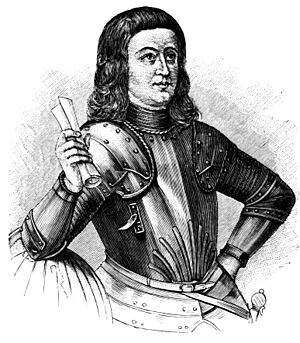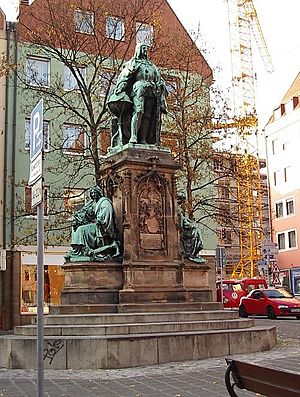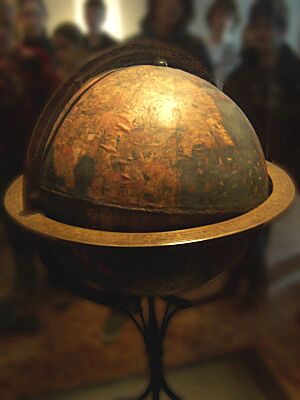Martin Behaim facts for kids
Quick facts for kids
Martin Behaim
|
|
|---|---|

Martin Behaim. Engraving from Narrative and critical history of America, Volume 2 by Justin Winsor
|
|
| Born | 6 October 1459 Nuremberg |
| Died | 29 July 1507 Lisbon |
Martin Behaim (born October 6, 1459 – died July 29, 1507) was a German merchant and mapmaker. He is famous for creating the Erdapfel, which is the oldest surviving globe in the world. He made this globe in 1492 for his hometown, Nuremberg.
Behaim also worked as an advisor to King John II of Portugal on navigation. He even took part in a sea journey to West Africa.
Contents
Martin Behaim's Life Story

Martin Behaim was born in Nuremberg, Germany, on October 6, 1459. He was the oldest son in a well-known and wealthy family. His father was a merchant who traded goods across Europe. Because his family was important, Martin likely received a good education.
Early Career and Travels
When Martin was 15, his father passed away. His uncle sent him to Mechelen, Flanders, to learn about the textile business. He worked with Jorius van Dorpp, who sold clothes. Later, he moved to Antwerp, a major center for cloth trade, to improve his business skills.
Moving to Portugal
In 1484, Behaim moved to Lisbon, Portugal. Lisbon was a busy port with trade routes to Africa, bringing spices, gold, and other goods. Martin was probably looking for new business chances there.
He quickly became a trusted advisor to King John II of Portugal. People believed he gave advice on navigation and astronomy. However, historians now think he didn't make big new discoveries in these areas. He might have helped by importing scientific tools, as the best ones were made in his hometown of Nuremberg.
In 1485, King John II made Behaim a knight. This was probably for his advice on navigation and astronomy, though the exact reasons are not fully known.
Voyage to West Africa
Around 1485, Behaim seems to have traveled to West Africa. It's most likely he joined a trading trip to Guinea led by João Afonso de Aveiro. Some people claimed he went with the explorer Diogo Cão on his second journey, but this is probably not true.
Life in the Azores and Return to Nuremberg
In 1486, Martin Behaim married Joana de Macedo. They lived on Faial Island in the Azores, where his father-in-law was a leader of the Flemish community.
In 1490, Behaim went back to Nuremberg for three years to deal with a family matter. While there, he convinced city leaders to pay for the creation of his famous terrestrial globe. He returned to Faial in 1493 and stayed there until 1506.
Martin Behaim died in Lisbon on July 29, 1507, while on a business trip. He was 47 years old.
Unproven Claims About Martin Behaim
Over time, many claims have been made about Martin Behaim's achievements. However, modern historians have looked closely at these claims and found that many are not supported by evidence.
Did Behaim Discover America?
Some people, like historian Johann Christoph Wagenseil, claimed in 1682 that Behaim discovered America before Christopher Columbus. Others said he at least gave Columbus the idea to sail west. There is no proof that Behaim ever sailed west on a discovery voyage. While it's possible Behaim and Columbus met in Lisbon, neither of them ever mentioned such a meeting.
Was He a Great Scientist?
Behaim has been called a great mathematician and astronomer. However, there's no evidence he had a scientific education or wrote any scientific papers. Behaim himself claimed to be a student of the famous mathematician Regiomontanus. Regiomontanus lived near Behaim in Nuremberg when Martin was a boy, but there's no proof they ever studied together.
Did He Sail with Diogo Cão?
Some biographers claimed Behaim went with Diogo Cão on his second voyage of discovery to Africa. Behaim might have caused this confusion himself by giving a unclear account of his own African trip in 1485. The dates don't match, and there's no independent proof that Behaim sailed with Cão.
Did He Influence Magellan?
Antonio Pigafetta, a writer who traveled with Ferdinand Magellan, suggested that Magellan knew about a passage to the "Southern Sea" from a map made by Behaim. Historians now doubt Behaim had direct knowledge of such a passage. However, he might have drawn mysterious passages on his maps that Magellan later interpreted as the strait he discovered.
The Behaim Globe: Erdapfel
After Martin Behaim returned to Nuremberg in 1490, city leaders agreed to pay for the creation of a special globe. Under Behaim's guidance, a team of skilled workers built what is now the oldest globe still in existence. An artist named Georg Glockendon drew the maps based on Behaim's instructions.
What is the Globe Like?
The globe is about 21 inches (51 cm) wide. It was made from a material like papier-mache and covered with plaster. It stands on a wooden tripod and is held together by iron rings. Glockendon's map drawings were painted on strips of parchment and then glued onto the sphere.
The globe has more than 2,000 place names. It also features 100 pictures, including animals and monsters, plus 48 banners and 15 coats of arms. There are over 50 long descriptions, many of which talk about strange creatures, plants, and people from faraway lands. Other notes describe trade, explorations, and famous travelers like Marco Polo.
How Accurate Was the Map?
The world map on Behaim's globe was mostly based on the geography described by Ptolemy, a geographer from the second century. It also included information from other sources, such as Marco Polo, John Mandeville, and Portuguese explorer Diogo Gomes.
However, the globe is missing some newer Portuguese geographical information that Behaim should have known. It also contains many errors that didn't match the best geographical understanding of the time.
Where is the Globe Now?
The people of Nuremberg called the completed globe the Erdapfel, which means "earth apple." It was first kept in Nuremberg's city hall. In the 1600s, the Behaim family took ownership of it.
The globe was repaired in 1823 and again in 1847, but these repairs unfortunately damaged many of the place names and labels. Today, the German National Museum in Nuremberg owns the globe, which is commonly known as the Nuremberg Terrestrial Globe.
This globe is very old and was made just before the discovery of the Americas. This makes it not only the oldest globe but also a kind of encyclopedia of what Europeans knew about the world in 1492.
See also
 In Spanish: Martin Behaim para niños
In Spanish: Martin Behaim para niños
- German inventors and discoverers
- German inventions and discoveries





